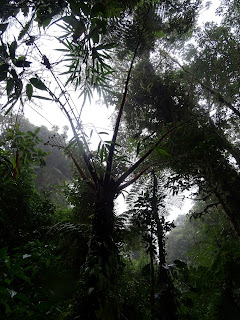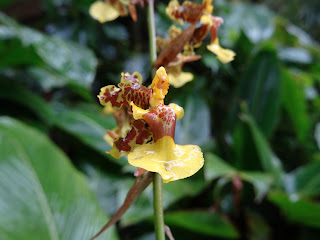Leaving around 5:00am on the 22nd, by mid-day I was dusting off my Spanish to arrange our transportation from the airport to Monteverde. We packed light, real light, sporting only a backpack each. Driving was considered but in the end it would have added un-needed stress and it ended up that shuttling around in vans was the cheaper option and a good way to take in the scenic drive south.
Leaving the arid Guanacaste province in the northwest we made our way into Puntarenas province going up into the mountains via winding, pot-hole ridden roads with precipitous cliffs and spectacular views at every turn. Munching on the "limon y sal" plantain chips that I so easily get hooke don while in Latin American countries, we found ourselves in Monteverde around 3:00pm.
As a by-product of the almost constant mist blowing westward from the Caribbean over the continental divide, you can almost always find a rainbow somewhere, or 2 or 3. I have shots of rainbows shooting out of Alyssa's palm, rainbows over bull-fighting rings, rainbows over grassy meadows with grazing cows, but the picture below captures the transition from agriculture to forest pretty accurately.
We got settled in to the Mar Inn, enjoyed the balcony view which looked over the town and as far away as the Gulf of Nicoya, 30 km in the distance. The first bird for the list was the ever-present Great-tailed Grackle, a very vocal bird and in the absence of a cell phone or alarm, a pretty reliable wake up in the morning. Turkey Vultures and Black Vultures could be seen at most times circling high above the valley. I've done my best on ID's with everything I saw, but if by chance I'm off, feel free to comment. My co-worker Charlotte had lent a few good references which helped me sleep better being able to put some names to faces.
We picked up some groceries and went for dinner at a soda (a type of restaurant serving mostly traditional dishes on the cheap). Monteverde is certainly a tourist town with many hostels and language schools *cough* brats partying on daddy's dime *cough*, but there are outdoor activities for everyone from the ATV/zipline crowd to the naturalists. After dinner we had a couple of beers o the balcony and decided we would head to the Jardin de Mariposas (Butterfly Garden) the next day to prime ourselves on the butterflies we might encounter. My co-worker Jessica Linton had volunteered there years ago and had recommended we pay a visit.
Early Saturday we had a nice breakfast, coffee was great without fail, and made our way to the butterfly spot. A stop at the bank yielded the $40,000 colones that I could get before BMO decided to flag my credit card for fraud and shut it down for the rest of the trip. I had read a few days prior that they no longer require you to notify when traveling, and my flight was paid for not 2 weeks prior on that same card, but anyways, Alyssa picked up the bill on everything for the next 6 days.
On the upside, while Alyssa was being successful in her banking endeavours, I went outside with my binoculars to have a look around. A few birds were fluttering around in a tree by the parkinglot including this Red-legged Honeycreeper [ebird map], the additions to the life list were picking up steam now!
A Tennessee Warbler happily gleaning berries from the same tree.
Tropical Kingbird could often be found on the hydro wires throughout town.
Strangler Fig trees could be found in forested areas on our walk. These trees establish among the branches/canopies of existing trees, grow downwards, setting root and eventually envelop (and often kill off) their host. The fruits are well enjoyed by local monkeys; the one type of wildlife on the hit list that we didn't see the whole trip (despite me secretly filling Alyssa's backpack with bananas as bait) - kidding.
Members of the Agave sub-family (Furcraea spp.) are found along roadsides, appearing planted in some cases. There are several species throughout Costa Rica.
Arriving at the Jardin de Mariposas we were introduced to some captive insects including scorpions of the Buthidae family.
A deceased specimen of a Hercules Beetle was interesting to see. Growing to as large as 17cm in length, these are among the largest beetle species known. These beetles, part of the Rhinoceros beetle family go through a 3 year larval stage before living out a 3-4 month beetle stage where they fly (yes, this thing can actually fly), breed and die. The species can reportedly carry 850 times it's bodyweight, about 5 lbs!
Leaf Katydid
An Orb-weaving spider (Nephila spp.) sitting in a web in the classroom rafters.
A Walking Stick insect (Order Phasmatodea).
And a handful of Ironclad Beetles (Family Zopherinae). Apparently mounting of these requires the use of a drill bit to puncture their solid exoskeleton.
Then it was on to visit 4 different micro habitats supporting a diversity of butterflies native to Costa Rica. Apparently there are more species of butterfly at Monteverde than in Canada, U.S and Mexico combined. A huddle of Owl Butterflies working away on some papaya, looks like we had the same thing for breakfast. Butterflies which eat rotting fruit can essentially become drunk if the fruit has begun to ferment.
A Blue-frosted Banner. We ended up seeing this species, and many of the species at the Butterfly Garden in the wild, so it was quite informative before heading out into the wild.
A Zebra Mosaic pulls up a stool at the bar.
Banded Orange
Julia
Sara Longwing (top) and Zebra Longwing (centre)
Cydno Longwing
Small Postman; we saw a fair number of these on some of the flowery roadside areas.
The elegant Blue Morpho which resembles the Owl Butterfly but is quite flasy with it's iridescent blue upper side of the wings.
Giant Swallowtail
Malachite, which does actually have a greenish colour to it like the mineral, just not apparent in this photo.
My favourite on the day were the Glasswing butterflies (Pteronymia spp.)
A Monarch caterpillar feeds on Tropical Milkweed (Asclepias curassavica).
The vines in the Mucuna genus produce the compound dopamine and have been studied for used in the treatment of Parkinson's disease. Howler Monkeys have been known to eat portions of the plant.
A stunning Passionflower in the butterfly garden.
We also got to see a Leaf-cutter Ant colony hard at work. Longs trails of them moved all around us on limbs and the ground.
Sunday it was off to Santa Elena Reserve, one of the stops I was most excited for. This location is similar to Monteverde Reserve (for a later post), but sees maybe 5-10% of the crowds. Monteverde is sometimes referred to as the Monteverde "Crowd" Forest; it can get pretty high traffic at certain times of the year and in the early morning.
We connected with a guide upon our arrival, Henry was a local quite experienced with the avifauna of the area. His expertise was much appreciated in that he knew some hotspots and it certainly helped having his quick ID and background knowledge of different species. Unfortunately it poured rain much of the day so under dark and wet conditions, photo ops were kind of limited.
Alyssa got a good smell of one of the native Bignonia species.
Henry showed me the leaves of the Trumpet Tree. It only took 5 minutes before I felt that I was monopolizing the guide for his knowledge, but most in our group were just there for a nice walk while I feverishly scratched down what Henry said word for word on my write in the rain paper (happy I brought some!).
Tree ferns can be found in semi-open canopies and take you back to prehistoric times.
Many trees had extensive buttressed trunks, this one even had a hole to my right with an Orange-kneed Tarantula living in it.
Lichens, mosses, and ephiphytes (vegetation which grows on the surfaces of trees, at various heights along the trunk and into the canopy) were everywhere! Their abundance makes you appreciate the concept of unique habitats and communities being stratified at different heights within a forest.
A number of bromeliads are ephiphytes and these are pollinated largely by birds, insects and bats. There are more than 200 species of bromeliad in Costa Rica. Fun fact, Pineapple is actually a bromeliad.
That's what I call lush vegetation!
Of the 20,000 or so species of orchid in the world, there are more than 1500 species in Costa Rica, about 800 of which are found in Monteverde. Those numbers can really put relative diversity into perspective.
I recognized this; in Ontario we have Pokeweed (Phytolacca americana). In Costa Rica you can find Venezuelan Pokeweed (P. rivinoides).
Red blooms seem to dominate in the forest groundcover and shrub layer. The plant below is known as Hooker's Lips (Psychotria elata). Earlier in the year this flower would appear just like bright red lips, here it's kind of gone by.
Drymonia rubra, found throughout Costa Rica, Panama and Colombia [map].
Black Guan, these birds creep silently through the wet montane forest canopies, impressive given their size of about 60cm. We saw 2 over the week but I only got a brief glance at the blue face. [ebird map]
Another species with a range limited to Costa Rica and western Panama, the Sooty-capped Bush Tanager [ebird map]. The similar Common Bush Tanager was one of the more common species in Santa Elena and Monteverde Reserves, at least where we hiked.
The female Purple-throated Mountain-gem (the male has the purple throat). [ebird map]. This species is the default pollinator for the Hooker's Lips plant earlier in this post. Monteverde is renown for it's hummingbird diversity. A clip in a later post captures the kind of activity you get at nectar feeders at the park nature centre.
I was glad I scaled several flights of stairs to the top of a viewing tower (despite being limited by 50m visibility in the mist/rain above the canopy) to see a pair of Ruddy Treerunners. These creeping individuals feed on insects found in mosses and bromeliads and nest in crevices on the underside of branches. Again, another species with a highly restricted range, essentially the Costa Rican highlands [ebird map].
Ending the day at the nature centre I noticed the massive leaves of a plant I know as Nalca. On a few trips to Chile I've purchased Nalca with a packet of salt from a street vendor; it's essentially like a rhubarb you can eat raw. This is likely a different species but still of the Gunnera genus.
I thought I'd liven up the blog with some video material too. Here is a 360 sweep taken along a trail at the Santa Elena Reserve.
And the cherry on top. Upon returning to our hotel, the sun was beaming down as a flock of Crimson-fronted Parakeets had just circled a rainbow in the valley (pretty cheesy hey?). We looked up in the tree off the end of our balcony and there, sleepy contently was a Two-toed Sloth. What a good start to the trip!

























































wow!! Can't wait to see the rest of the photos! I love the sloth and the Emerald Toucanet!
ReplyDeleteA great collection of images, Patrick. I was there several times more than 25 years ago, and Monteverde was crowded enough then. I can't imagine what it would be like these days.
ReplyDeleteLooking forward to more on your trip.
Thanks for taking the time to discuss that, I feel strongly about this and so really like getting to know more on this kind of field. Do you mind updating your blog post with additional insight? It should be really useful for all of us. ontario airport shuttle
ReplyDelete